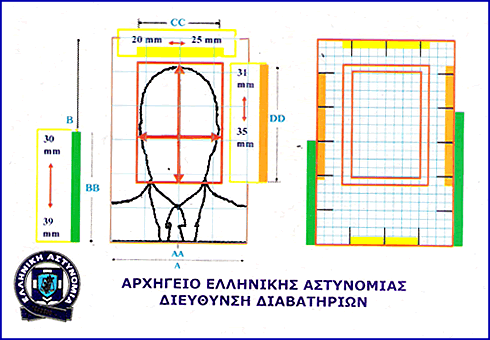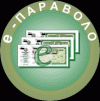Along with the application for the issuance of a passport you have to submit one (1) current photograph. The photograph for the requested passport should have the following technical specifications:
A) Dimensions and Paper Quality
- Must be recent.
- The dimensions of the photograph should be 40 mm x 60 mm without frame.
- Must be produced or printed on high quality white photographic paper, not watercolored or relief.
- Must be high analyzed and shouldn't have dots (pixel - raster) or be produced on ink jet or laser printers.
- The person must appear such as the following shape, so that:
- The face length DD (from the jaw up to the top of the head) should be 31 mm up to 35 mm.
- The face width CC (from the one ear to the other at the connection point to the face) should be 20 mm up to 25 mm.
- The distance BB from the lower part of the photo up to the eyes (the imaginary line which crosses between the eyes) should be 30 mm up to 39 mm.
- NOTE: Analogically, none of the upper indications should overrun the lower or upper price. Furthermore face deformation is not allowed.
- It should be taken at white or cream background or at use of 5% of grey, so that the face characteristics will be clear in relation to the used background.
- For people with moving or other health problems should be made an effort of taking the photo as well as possible.

B) Proper way of taking photos
- The photos should be clear, distinct and they must render the natural colors of the face, without color saturation.
- The printed photos, taken from a digital camera, must be analyzed at least at 1200 dpi or more.
- The paper used should not appear grey spots (Newton Circles) when pressured, while it's tested at a transparent glass surface.
Furthermore:
- The entire face should be clear, from the jaw to the forehead and from the one ear to the other.
- Shadings mustn't appear on the background and the face or sheens from the light reflected to the face.
- Except the person photographed, any other persons or objects such as dolls, toys etc are not allowed to be appeared.
- The person must appear looking straight at the camera's lens.
- The person must appear with a neutral expression and a closed mouth.
- The person must appear with the eyes open (not wide open) in a way that they can be seen clearly. Sunglasses and myopic glasses with colored lenses (Photo Gray, Photo Brown etc) are prohibited. The hair must never cover the eyes, the eyebrows or any part of the person's face.
- The person must appear without a reflection on the glasses, in case he/she's wearing and the glasses frame mustn't cover the eyes or other face characteristics. To prevent this kind of problems, it's recommended not to wear eye glasses, when it is possible.
- The person must appear without a head cover.
For religious reasons a person can wear a head cover (for example a kerchief etc), but the face characteristics from the jaw up to the forehead and from the one ear to the other must be in any case visible.
Also, for health problems it is allowed to cover face characteristics (a medical certificate should be submitted).
Children under 12 years old and babies. Regarding children under 12 years old and babies, photos dimensions can be logically smaller from these of the adults and they must be accepted.
Examples of appropriate photos referenced to the pose, the expression, the background etc and not to the face dimensions:
Pose
The frontal photo type must be used for the passport's photo. The head rotation must be less than +/- 5 grades from the center at every direction (up and down, left or right). The shoulders must be "straight". The "portrait style" photos, in which the person looks over the one shoulder, are not accepted.
Expression
The expression must be neutral (without a smile), with both eyes normally open (not wide open) and the mouth closed. The biggest effort must be made, so that the pictures delivered will be according to the current specifications. Smile with closed mouth is not recommended. The person must be entirely alone (without backs of chairs, toys or other faces appeared), looking at the lens with neutral expression and closed mouth.
Examples of not accepted expressions
- Closed eyes
- Eyes covered by hair
- Eyes partly covered by glasses frame
Examples of not recommended expressions
- Smile and the teeth or the inside of the mouth is visible
- Eyebrows rise
- Eyes which don't look straight at the camera
- Squint
- Frown
Background
The limit between head and background must be totally distinct in the entire object (bushy hair is acceptable). There must be no shades at the face's background.
Shadows in the eyes
There must be no dark shades in the eyes because of the eyebrows. The iris and pupil must be distinctly visible.
Background sameness
The background must be plain without straight lines or curves. So it must be uniform or homogenously colored, with smooth vacillations of the lightness to only one direction.
Subject and background lighting
The lighting will be spread uniformly in every side of the face. No significant direction of the light must be visible from the photographer's optical angle.
Hot spots
Great attention must be given to avoid "hot spots" (bright areas of light which make the face shine). This phenomenon is usually being caused by the use of a highly bright intensity and concentration. Instead of that it's essential to use expansive light, multiple equal sources or other lighting methods.
Glasses
If the person usually wears glasses, then he/she must wear them when photographed. The glasses must be clean and transparent, so that the iris and pupil are clearly visible. If the glasses are getting automatically dark to the light, the person must be photographed in such a way that that the glasses won't change color. Only in extreme cases, in which the changing of the color can't be reduced, the glasses must be taken off.
Dark glasses or sunglasses are acceptable only for medical reasons. In different situation they must be taken off.
It must be made sure that glasses frames don't cover the eyes.
There must be no light reflection on the glasses. This can usually be achieved by modifying the angle among the source of the light, the object and the camera at 45° (degrees) or more.
Eyes bandages
Use of bandages at the eyes is allowed only for medical reasons.
Not exaggerated or deficient exposure
For every detail of the face, the color gradations must be clearly visible. So there must be no saturation (from exaggerated or deficient exposure) to the face.
Focus and depth of the field
The picture must be perfectly focused from the nose to the ears and the jaw up to the hair. This can lead to background obscureness, but it's not a problem. During a typical photographing, for the best quality of the face, the f-stop of the camera lens must be adjusted at two (or more) f-stop under the highest stop opening, so as to achieve enough depth field.
All the pictures will have satisfying depth focus so as to maintain a better analysis from 2 mm at the photographed face. It can be achieved a better picture analysis than 1 mm, if in a test photographing the millimeter signs, placed at the nose and the ears or the face of the person that looks at the camera, are visible.
If the camera lacks of an automatic focus, then the person must be placed always at the best position.
Unnatural color
The unnatural colored light, yellow, red, etc is not allowed. Attention must be given to correct the balance of the white light of the camera. The light will give to the face at the picture a natural tone of the flesh. The "red-eyes" phenomenon is not allowed. The colored photos must be based on techniques of balanced colored light, like for example high temperature of the flash color.
Color or tone of grey gradation
A procedure which aims at exaggerated or deficient exposure of a color or a tone of grey for esthetic reasons is not allowed. The whole of the picture is requested. The teeth and the white of the eyes will be open colored or white (wherever needed) and the dark hair or characteristics (wherever needed) will be dark.
Actinic deformation of the camera lenses
The "fish-eye" phenomenon which is related to unusually big noses is not allowed. There is almost always some kind of deformation at portrait style photographing, but that deformation must be unnoticed during the human examination.
The actinic deformation due to the lens is a phenomenon, which has to be reduced. For a typical photographic system with the object at a distance of 1,5 m up to 2,5 m from the camera, the focal length of the lens must be as much as a typical telephoto lens. For example, for a photo of 35 mm is needed a 90mm to 130 mm focal length of a lens. Practically, about the various optical sensors, the recommended focal length is 2 to 3 times the diagonal of each sensor.
Picture at the center
The approximately middle points of the mouth and the nose must be met at an imaginary perpendicular line AA, which is placed in the horizontal center of the picture.
You can download Greek comprehensive text with the technical specifications of passport photograph:







